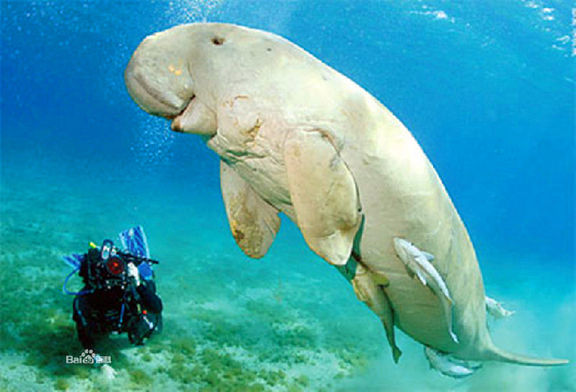Preserving S. China's endangered dugongs
 0 Comment(s)
0 Comment(s) Print
Print E-mail Xinhua, September 17, 2013
E-mail Xinhua, September 17, 2013
Every morning, Huang Yilong looks out at the sea, hoping to catch a glimpse of the dugongs once abundant in his hometown of Beihai, a coastal city in south China's Guangxi Zhuang Autonomous Region.
 |
|
A file photo of dugong. |
The 85-year-old fisherman said he and his fellow villagers had not seen the rare creatures for many years, and they could only live with the memories of the lovely "mermaids" now.
Dugongs, also called sea mermaids or sea cows, were once common in the Shatian shallow sea area in Beihai's Hepu County, the animal's habitat in the country before the 1980s. When a dugong feeds her calf, it looks like a human mother nursing a baby, earning them the "mermaids" nickname.
Dugongs live on sea grass and can grow to three meters and weigh as much as 500 kg. They live in shallow, tropical waters throughout the Indo-Pacific region. Australia has the largest concentration of dugongs in the world, estimated at 70,000 in 1991.
"When I was young, I always saw these 'mermaids' coming ashore to feed on sea grass," Huang said.
But the proliferation of fish farms and seawater pollution in the area caused the animal's numbers to decrease sharply. Local residents in Hepu believed they might have become extinct or moved elsewhere.
Due to human threat, the animal has been listed as a species vulnerable to extinction by the International Union for Conservation of Nature.
Most of Hepu's local villagers in their 40s or older said they saw the dugongs when they were young, and some even had close contact with the creatures.
"Whenever the dugongs saw us swimming by the seaside, they would immediately kneel and wave to us like human beings," Huang Yilong said with a sense of nostalgia.
Pang Xianzhang, a 67-year-old villager, said the dugongs were deemed divine creatures in the past, and local people never tried to catch them. But everything changed in 1958, when the country was going through the "Great Leap Forward" and the "People's Commune" era.
Pang said the commune required local fishermen to provide a large amount of fish during light seasons, and they had to begin catching the fat dugongs. The hunt for the mammals did not stop until 1962.
"In just five years, more than 200 dugongs were killed," Huang said with regret, adding that he was among the culprits who ate the dugong meat.






Go to Forum >>0 Comment(s)